|
Growing Micropropagated Sweetpotatoes
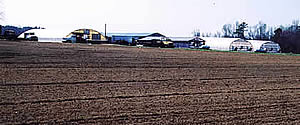 |
We
have a separate greenhouse for each variety that we get from the NC
State University Micropropagation Unit. A wood-frame greenhouse--
20'X80' - 1/3 center area is screened in for mother plants. |
 |
Each
greenhouse features electricity on thermostats and automatic timers
for water and fertilizing. |
 |
Before
entering each greenhouse, everyone goes though a double entry area
for sterilization with a fogging system that complete covers the body
to eliminate insects and diseases getting into the greenhouse. We
don't feel it's enough to just step in a clorox-filled tub.
|
 |
At
the start of each growing season, we sterilize everything with a Clorox/
Oxidate/fungicide/
spore killer mixture to make sure everything is spic 'n' span and
ready for new mother plants to be micropropagated. |
 |
 |
Around
the 1st week of Feb. we pick up plants in 4" clay pots from the
NC State MPU. We get 50 plants of four different varieties with a
color-coded label for each variety. |
 |
We
immediately re-pot the mother plants into 3-gallon pots or hanging
baskets that were previously fillled with special potting soil and
watered thoroughly. We want to make sure our new plants can grow and
not be root bound. |
 |
As
the mother plant grows runners, we spray alcohol on clippers before
making each cut at the second node joint to make sure we are not transmitting
any viruses. |
 |
Jessica
places 7 to 8 second-node cuttings in a hanging basket, which are
hung in the greenhouse just outside the caged mother plant room |
 |
These
first daughter cuttings, with each pot labeled to show what mother
plant it came from, continue to grow . |
 |
|
 |
| As
they grow, Jim and Jimmy take 2 node cuttings from each first daughter
plant, which will be planted in another greenhouse with the same variety.
|
 |
Each
of our greenhouses has ground cover and gravel on the floor for drainage,
as well as drain lines that run underground to remove any standing
water. |
 |
Jim
and Jimmy punch holes in the soil ready for second daughter cuts. |
 |
Jim
and Jessica spacing and planting second daughter cuts in 6" rows,
with each plant about 4" apart. We have about 18-20,000 plant
capacity in each greenhouse. |
 |
Jim
adjusts irrigation pipes to water second daughter plants. |
 |
Second
daughter plants are now ready for transplanting and making seed stock
in the field. |
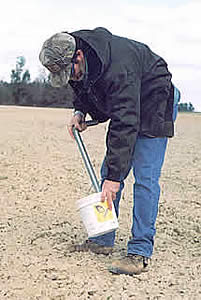 |

Prior to planting,
we sample and meter the soil in all our sweet potato fields to determine
what nutrients are needed to grow a good crop.
|
 |
 |
| Starting
about the first or second week of May, plants are cut every 8-9 days
for 7-10 weeks for transplanting in our fields, We practice select
cutting, using clippers to get the biggest plants to grow. We give
the smaller plants time to get bigger before weekly cuttings and transplanting
in the field. |
 |
Irrigation
is key to growing quality plants and assuring a good stand. To get
a good, uniform stand, a grower must irrigate if there has been no
rainfall.
|
 |
Applying sidedress
fertilizer four weeks after transplanting will help ensure us of a
good high yield of uniform #1 sweet potatoes. |
 |
Moving
vines 8-10 days before digging with plow. |
 |
|
Digging
with 2-row plow
|
 |
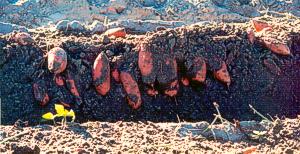 |
|
Potatoes
upturned by digger.
|
 |
Bins
and buckets are sterilized before harvest time. Harvesting crew separates
seeds from #1's, carefully handling them as they're placed in bins
for storage. |
 |
Curing
boxes
(each holds 40 bushels)
of sweetpotatoes on truck.
|

In the curing shed, sweet potatoes are cured and stored over winter.
They are kept for 4 to 5 days at 85 degrees and 85 percent humidity
and then down to 55 degrees at 85 percent humidity for the duration
of the time in the curing barn. |
|

With the right
micropropagated seeds or plants and, God willing, mother nature's
cooperation we will have the very best crop of sweetpotatoes under
our rows.
|

 |
 |
We
grow our micropropagated 1st generation seed potatoes in field beds
to make 2nd generation plants, which become our commercial potatoes
and 2nd generation seed for sale to other growers. We start by placing
the seed potatoes as close as we can without stacking. |
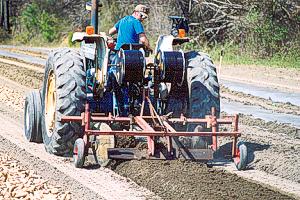 |
We place 2 lines
of drip tape for irrigation as we cover seed beds with soil. |
 |
|
The
beds are covered with plastic
|
 |
 |
Jim's
wife, Barbara, punches holes in the plastic to allow air to circulate
on the plant bed. Along with water, we add nutrients once a week through
irrigation drip tape. |
 |
 |
 |
G-2
plants come from our G-1 field seed beds. They are hand selected to
ensure uniform, healthy plants that will produce high yielding good
quality G-2 sweet potatoes. |
Micropropagation
Brings Sweet results
to North Carolina Growers
With farmers in dire
need of something to generate bank deposits after tobacco’s lean
years and the damage from the 1999 hurricane season, micropropagated sweetpotatoes
just might be the crop to boost cash flow in years to come.
The sweetpotato, North
Carolina’s official vegetable, brought in $60 million in cash receipts
last year from the more than 37,000 acres grown on the western edge of
our state’s coastal plains, home to much of the nation’s crop.
 |
Due mostly to
seed stock improved by the College of Agriculture and Life Sciences’
Micropropagation Unit (MPU) at N.C. State University, a total of
about 40,000 coastal plains acres probably will go to sweetpotatoes
this year, says Dr. Zvezdana Pesic-van Esbroeck, MPU director.
Micropropagation
is the carefully controlled generation of plants from a few cells
of an original plant, which allows massive plant regeneration from
originals that have been checked for disease and other problems.
The MPU meets
the increasing demands of North Carolina’s fruit and vegetable
industries for pathogen-free, virus-indexed, true-to-variety, asexually
propagated stock plants.
N.C. State researchers,
Cooperative Extension specialists and county agents, who in 1988
introduced the first micropropagated sweetpotatoes into North Carolina
fields, strive to hold and improve the plant’s national market
share. That share already is a healthy 40 percent, say statistics
from the North Carolina Sweetpotato Commission Inc.
|
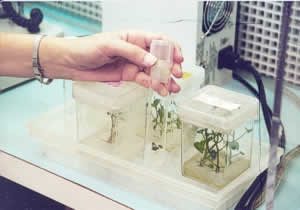 |
To produce micropropagated
plants, researchers such as Pesic-van Esbroeck and Dr. Marilyn Daykin,
a tissue culture specialist, grow tiny groups of meri-stematic cells
— located at the leading edge of the plant’s growth —
under controlled laboratory conditions at the MPU, generating small
plants called mericlones.
Mericlone production
in the lab bears no relation to the process that creates transgenic,
or genetically modified, organisms.
|
"No sweetpotato
mericlone genes are altered or transferred from one plant to another,"
Pesic-van Esbroeck says.
Researchers check
the clones, and pathogen-free mericlones are multiplied — "increased,"
in growers’ language —through in-vitro techniques.
Later, scientists
make cuttings to further increase the mericlones in isolated, insect-free
greenhouses at the Sandhills Research Station in Montgomery County.
 |
The MPU’s
sweetpotato research is part of a continuing College effort to assist
growers. College departments such as Plant Pathology, Horticultural
Science and Entomology have cooperated with Extension and growers
to help the sweetpotato buck stiff competition from other states.
Extension workers
and researchers also help protect the crop from diseases such as
the russet crack strain of the feathery mottle virus and against
genetic drift, which happens if several generations of the same
mother plant’s roots — not the preferred vines —
are used for seed stock and replanted in the same field.
"The MPU
avoids that problem through cloning the sweetpotato’s vine
at the spot where it’s growing, the meri-stem," says Pesic-van
Esbroeck. "A virus and other plant pathogens can be present
everywhere in an infected plant but only rarely in the meristematic
tissue."
|
Since the cleanest
stock comes directly from the MPU, North Carolina Foundation Seed Producer
growers must refresh their stock from the N.C. State greenhouse annually.
Only that stock guarantees commercial sweet potato growers hill-selected,
tissue-culture-generated, field-evaluated stock. But one such plant can
translate into millions of sweetpotato plants in the field in a year.
 |
The field is
yet another place where researchers exercise quality control. Breeders
Dr. Craig Yencho of the Vernon James Research and Extension Center
in Plymouth, Kenneth Pecota of the College’s Horticultural
Science Department, growers and others walk through harvested plantings
yearly, while roots still are attached. They examine hundreds of
plants, looking for the best. They also evaluate the lab’s
existing mericlones in several fields to test for evidence of disease
and genetic drift.
Dr. Charles
Averre, a retired plant pathologist, helped develop the micropropagation
system at N.C. State. Averre; Dr. Robert Milholland, retired plant
pathology professor; Dr. Jonathan Schultheis, Extension horticulture
specialist; and Bill Jester, an Extension area specialist, developed
and demonstrated micropropagation procedures compatible with existing
North Carolina Foundation and Certificate programs. These procedures
ensured that sweetpotatoes stayed disease-free and stopped genetic
drifts.
|
"But the most
important thing about this program," says Averre, "is to give
our growers quality roots. Then they will have a comparative edge, and
that’s what pays off."
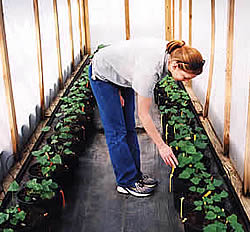 |
NC
MPU Lauren Hix came out to inspect our plants. Protocol of NC Crop
Improvement and Micropropagation Unit, inspected regularly once per
month. During these unscheduled visits, they inspect greenhouses,
look at plants, check for cleanliness, good housekeeping, etc. |
|

